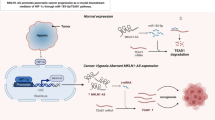Abstract
Objectives
To clarify the potential biological function of miR-93 and its related molecular mechanism underlying metastasis in human hepatocellular carcinoma (HCC).
Results
miR-93 was significantly up-regulated in HCC tissues and was associated with poor 5-year overall survival in HCC patients. Transwell assays showed that over-expression of miR-93 increased HCC cell migration and invasion in vitro. Programmed cell death 4 (PDCD4) was a target gene of miR-93 and miR-93 could down-regulate the expression of PDCD4 by directly targeting its 3′-UTR. The re-expression of PDCD4 could attenuate the HCC cell invasion and migration induced by miR-93, while the knockdown of PDCD4 would promote HCC cell migration and invasion via the epithelial-mesenchymal transition (EMT) pathway.
Conclusions
miR-93 provides new insight into the molecular mechanisms of pathogenesis and progression in HCC and offer a potential therapeutic target for the treatment of HCC patients.




Similar content being viewed by others
References
Bartel DP (2009) MicroRNAs: target recognition and regulatory functions. Cell 136:215–233
Chu KK, Cheung TT (2015) Update in management of hepatocellular carcinoma in Eastern population. World J Hepatol 7:1562–1571
Chung KY et al (2011) Block of proliferation 1 (BOP1) plays an oncogenic role in hepatocellular carcinoma by promoting epithelial-to-mesenchymal transition. Hepatology 54:307–318
Fornari F et al (2008) MiR-221 controls CDKN1C/p57 and CDKN1B/p27 expression in human hepatocellular carcinoma. Oncogene 27:5651–5661
Guo PT, Yang D, Sun Z, Xu HM (2013) PDCD4 functions as a suppressor for pT2a and pT2b stage gastric cancer. Oncol Rep 29:1007–1012
Kulik LM, Chokechanachaisakul A (2015) Evaluation and management of hepatocellular carcinoma. Clin Liver Dis 19:23–43
Kumar S, Das A, Sen S (2014) Extracellular matrix density promotes EMT by weakening cell-cell adhesions. Mol BioSyst 10:838–850
Li JZ et al (2016) The clinical association of programmed cell death protein 4 (PDCD4) with solid tumors and its prognostic significance: a meta-analysis. Chin J Cancer 35:95
Liang H et al (2016) miR-93 functions as an oncomiR for the downregulation of PDCD4 in gastric carcinoma. Sci Rep 6:23772
Negrini M, Nicoloso MS, Calin GA (2009) MicroRNAs and cancer–new paradigms in molecular oncology. Curr Opin Cell Biol 21:470–479
Ohta K et al (2015) MicroRNA-93 activates c-Met/PI3 K/Akt pathway activity in hepatocellular carcinoma by directly inhibiting PTEN and CDKN1A. Oncotarget 6:3211–3224
Tan G et al (2016) MiR-1180 promotes apoptotic resistance to human hepatocellular carcinoma via activation of NF-kappaB signaling pathway. Sci Rep 6:22328
Wang Q et al (2013) Down-regulation of programmed cell death 4 leads to epithelial to mesenchymal transition and promotes metastasis in mice. Eur J Cancer 49:1761–1770
Wei R et al (2013) Clinical significance and prognostic value of microRNA expression signatures in hepatocellular carcinoma. Clin Cancer Res 19:4780–4791
Xiao S et al (2016) Actin-like 6A predicts poor prognosis of hepatocellular carcinoma and promotes metastasis and epithelial-mesenchymal transition. Hepatology 63:1256–1271
Zhang H et al (2006) Involvement of programmed cell death 4 in transforming growth factor-beta1-induced apoptosis in human hepatocellular carcinoma. Oncogene 25:6101–6112
Zhang X et al (2014) F-box protein FBXO31 is down-regulated in gastric cancer and negatively regulated by miR-17 and miR-20a. Oncotarget 5:6178–6190
Zhou X et al (2015) miR-625 suppresses tumour migration and invasion by targeting IGF2BP1 in hepatocellular carcinoma. Oncogene 34:965–977
Acknowledgements
None.
Author information
Authors and Affiliations
Corresponding author
Ethics declarations
Conflicts of interest
None.
Rights and permissions
About this article
Cite this article
Ji, C., Liu, H., Yin, Q. et al. miR-93 enhances hepatocellular carcinoma invasion and metastasis by EMT via targeting PDCD4. Biotechnol Lett 39, 1621–1629 (2017). https://doi.org/10.1007/s10529-017-2403-5
Received:
Accepted:
Published:
Issue Date:
DOI: https://doi.org/10.1007/s10529-017-2403-5




